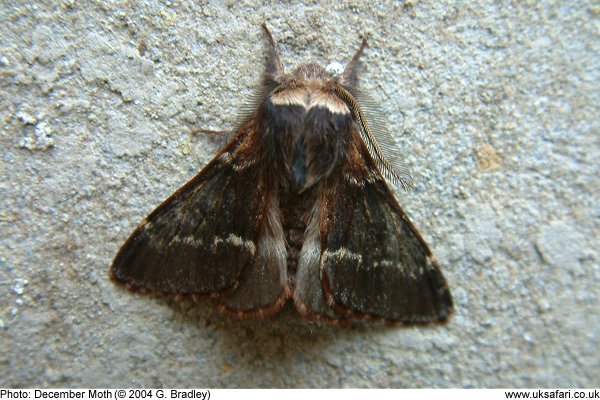 December Moths
December Moths
News > December Moths >

Christmas doesn't automatically spring to mind as a good time to go moth hunting, but surprisingly you can still find around 200 species in the UK, if you know where to look. Of course only a few are brave enough to be out flying on frosty nights. Most sleep through the winter in sheltered areas.
It has to be said that most winter moths are a bit... well... drab in appearance. But one which does stand out from the crowd is the super-imaginatively named "December Moth".
The body of the December Moth is covered with a coat of thick shaggy fur, and it really looks as if it's dressed for the coldest winter weather. With its cream striped, smokey-brown forewings its unmistakable, and if you're lucky, you might be able to spot one fluttering around the lighted windows of your home tonight.
December is mating time for December Moths, which seems like a jolly good way to spend the Christmas holidays. The males are smaller than the females and have large feathery antennae (see photo above). It's believed they use these to detect the females by waving them about to pick up their scent. Once they've mated the females will lay their eggs on a tree, but the caterpillars won't hatch out until spring, when there will be plenty of fresh leaves for them to eat.
More info at: December Moth Fact File

 Popular Pages
Popular Pages
Amphibians, Bats, Badgers, Beetles, Birds, Birds of Prey, Bumble Bees, Butterflies, Caterpillars, Creepy-Crawlies, Deadly Spiders, Dolphins, Dragonflies, E-Postcards, False Widow Spiders, Free Newsletter, Frogs, Fungi, Garden Spiders, Glow-Worms, Grey Squirrels, Hedgehogs, House Spiders, Ladybirds, Mammals, Marine Mammals, Moths, Owls, Reptiles, Spiders, Toads, Trees, Wildlife Hospitals
Copyright © 2020 G. Bradley UK Safari. All rights reserved | About Us | Links | Contributors



 Related Pages
Related Pages
